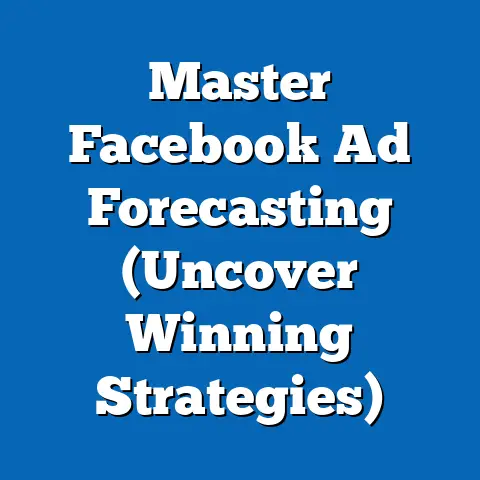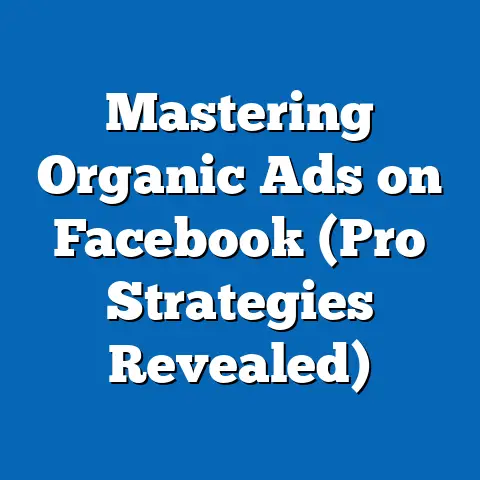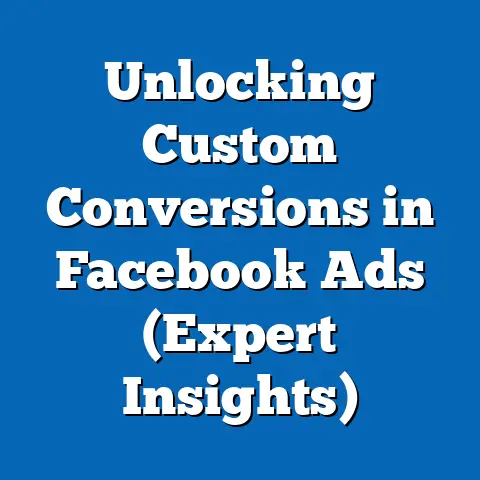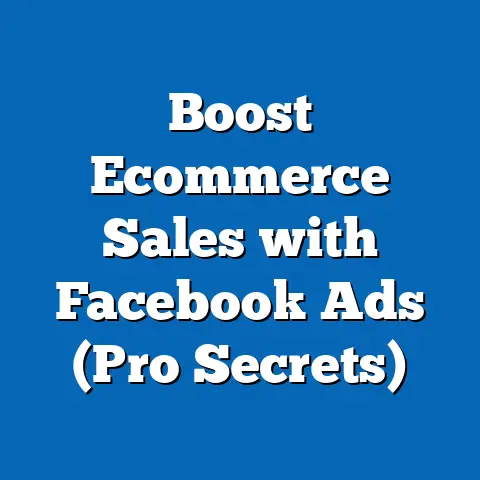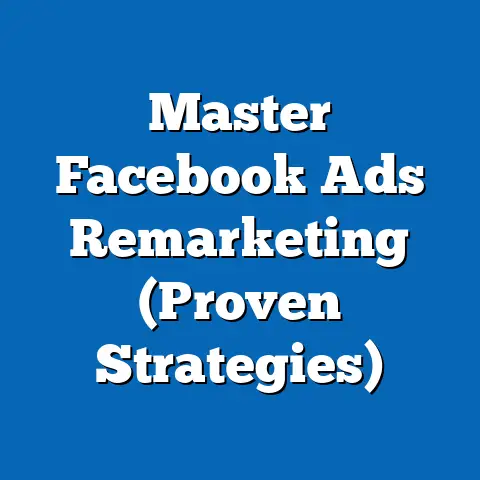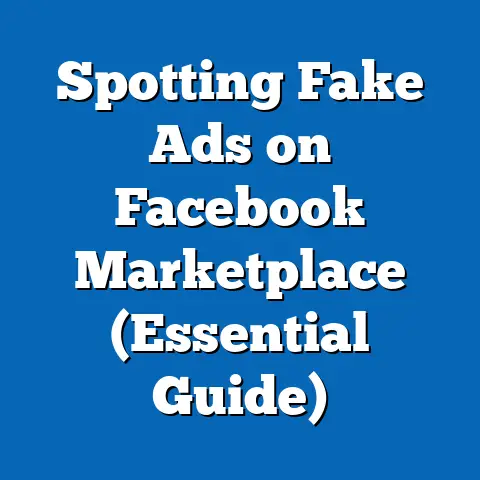Unlock Top Budget Facebook Ads Strategies (Expert Insights)
In the ever-evolving world of digital marketing, a powerful yet often underutilized secret lies in mastering budget-friendly Facebook advertising strategies. While businesses of all sizes pour billions into social media advertising, many overlook the potential to achieve remarkable results with minimal investment through targeted, data-driven approaches on Facebook. This “best-kept secret” is not about cutting corners but about leveraging expert insights, precise audience targeting, and creative optimization to maximize return on investment (ROI) without breaking the bank.
Facebook, now part of Meta, remains a dominant force in social media advertising, with over 2.9 billion monthly active users as of 2023 (Statista, 2023). Its advertising platform offers unparalleled opportunities for businesses to reach diverse demographics at a fraction of the cost of traditional media. However, the challenge lies in navigating the complexities of ad creation, audience segmentation, and budget allocation to ensure every dollar spent delivers measurable impact.
Defining Characteristics of Budget-Friendly Facebook Ads Strategies
At the core of successful low-budget Facebook advertising is a focus on precision and creativity. Unlike high-budget campaigns that rely on mass reach and expensive production, budget strategies prioritize hyper-targeted audiences, cost-effective ad formats, and iterative testing. These campaigns are often characterized by a deep understanding of the platform’s tools, such as the Facebook Ads Manager and Pixel tracking, which allow advertisers to optimize performance in real-time.
Another defining trait is the emphasis on organic-looking content. Budget-conscious advertisers often create ads that blend seamlessly with users’ feeds, using user-generated content (UGC) or minimalist designs to build trust without the need for high-end visuals. According to a 2022 study by Hootsuite, ads that mimic organic posts can achieve up to 25% higher engagement rates at a lower cost per click (CPC).
Finally, these strategies are rooted in data-driven decision-making. Advertisers with limited budgets cannot afford to waste resources on untested ideas, so they rely heavily on A/B testing, audience insights, and performance analytics to refine their approach. This iterative process ensures that even small investments yield significant results over time.
Historical Context: The Evolution of Social Media Advertising
To fully appreciate the significance of budget-friendly Facebook ads, it’s essential to understand the historical context of social media advertising. When Facebook launched its advertising platform in 2007 with “Facebook Flyers,” it introduced a revolutionary model that allowed businesses to reach users based on personal data and interests. This was a stark departure from traditional advertising, which relied on broad demographics and often required substantial financial investment.
In the early 2010s, as Facebook’s user base skyrocketed, the platform refined its targeting capabilities with the introduction of Custom Audiences and Lookalike Audiences. These tools enabled advertisers to pinpoint specific user segments and replicate successful audience profiles, leveling the playing field for smaller businesses with limited budgets. By 2014, Facebook had become a go-to platform for digital marketing, with ad revenue surpassing $12 billion annually (Facebook Annual Report, 2014).
The rise of mobile usage further transformed the landscape, as advertisers could now reach users on the go with cost-effective mobile-optimized ads. However, as competition intensified, so did the costs. Average CPC on Facebook increased by 17% between 2017 and 2020 (WordStream, 2020), pushing smaller advertisers to adopt smarter, budget-conscious strategies to stay competitive. This historical shift underscores the importance of today’s focus on efficiency and creativity in low-budget campaigns.
Societal Implications: Democratizing Digital Marketing
The advent of affordable Facebook advertising has far-reaching societal implications, particularly in democratizing access to marketing tools. Historically, advertising was the domain of large corporations with deep pockets for TV, radio, and print campaigns. Facebook’s low entry barrier—where campaigns can start with as little as $1 per day—has empowered small businesses, entrepreneurs, and even individual creators to compete on a global stage.
This democratization has fueled economic growth by enabling micro-businesses to reach customers without the need for expensive intermediaries. A 2021 Meta study found that 70% of small businesses using Facebook ads reported increased sales, with many citing the platform as their primary marketing channel. This accessibility fosters entrepreneurship, particularly in underserved communities where traditional advertising is cost-prohibitive.
However, there are challenges as well. The saturation of ads on social media has led to “ad fatigue” among users, with 74% of consumers expressing frustration over irrelevant or repetitive content (HubSpot, 2022). Budget advertisers must therefore prioritize relevance and value to stand out, ensuring their campaigns contribute positively to the user experience rather than detract from it.
Key Budget-Friendly Facebook Ads Strategies: Expert Insights
Drawing from expert perspectives and industry research, the following strategies represent the cornerstone of effective low-budget Facebook advertising. These approaches are designed to maximize impact while minimizing costs, offering actionable insights for businesses of all sizes.
1. Hyper-Targeted Audience Segmentation
One of the most powerful features of Facebook advertising is its ability to target specific user groups based on demographics, interests, behaviors, and past interactions. Experts like digital marketing strategist Mari Smith emphasize the importance of starting small with highly defined audiences to reduce wasted ad spend. For instance, instead of targeting “all women aged 18-35,” a budget campaign might focus on “women aged 25-30 who follow eco-friendly brands and live in urban areas.”
Using tools like Custom Audiences, advertisers can upload customer lists or retarget website visitors, ensuring ads reach users already familiar with the brand. Lookalike Audiences further amplify this by finding new users who resemble existing customers, often at a lower cost per acquisition (CPA). According to a 2023 report by Social Media Examiner, campaigns using Lookalike Audiences saw a 30% reduction in CPA compared to broad targeting.
2. Leveraging Cost-Effective Ad Formats
Not all ad formats are created equal when it comes to cost. Experts recommend focusing on formats like carousel ads and single-image ads, which are cheaper to produce and often outperform video ads in terms of cost per engagement. For example, a 2022 study by AdEspresso found that carousel ads have a 20% lower CPC compared to video ads while maintaining high engagement rates.
Additionally, using Stories ads can be a budget-friendly option, as they often have lower competition and cost less per impression. These full-screen, vertical ads are ideal for mobile users and can be created using simple tools like Canva, eliminating the need for expensive design software.
3. Crafting Compelling, Low-Cost Creative
High production values are not a prerequisite for successful Facebook ads. Marketing consultant Neil Patel advises focusing on authenticity over polish, using real customer testimonials or behind-the-scenes content to build trust. User-generated content, such as customer photos or reviews, can be repurposed into ads at virtually no cost, often resonating more with audiences than polished corporate imagery.
Another tip is to use bold, concise copy that grabs attention within the first three seconds. With users scrolling quickly through their feeds, headlines like “Save 50% Today Only!” or “Discover Your Perfect Fit” can drive clicks without relying on expensive visuals. Testing multiple ad variations through A/B testing ensures that the most effective creative is identified early on.
4. Optimizing for Conversions with Facebook Pixel
The Facebook Pixel, a small piece of code installed on a website, is a game-changer for budget advertisers. It tracks user behavior, such as page views or purchases, allowing advertisers to measure campaign effectiveness and optimize for specific actions. Digital advertising expert Amy Porterfield notes that Pixel data can reduce ad costs by up to 40% by focusing spend on users most likely to convert.
For instance, a small e-commerce store might use Pixel data to retarget users who abandoned their shopping carts, offering a discount code to encourage completion. This precision targeting minimizes waste and ensures every dollar is spent on high-potential leads.
5. Setting Realistic Budgets and Scaling Gradually
One common mistake among budget advertisers is expecting immediate, large-scale results. Experts like Gary Vaynerchuk advocate for starting with small daily budgets—$5 to $10 per day—and scaling only after identifying winning ads. This “test and learn” approach prevents overspending on unproven campaigns and allows for continuous optimization.
Facebook’s Campaign Budget Optimization (CBO) feature can further stretch limited budgets by automatically allocating funds to the best-performing ad sets. A 2021 case study by Meta showed that CBO reduced costs per result by 17% for small businesses compared to manual budget allocation.
6. Timing and Frequency for Maximum Impact
Timing is critical in budget advertising, as competition and user behavior vary by day and hour. Research by Sprout Social (2023) indicates that the best times to post ads are midweek (Tuesday to Thursday) between 9 a.m. and 2 p.m., when engagement rates are highest. Budget advertisers should use these insights to schedule ads during peak activity periods, maximizing visibility without increasing spend.
Additionally, controlling ad frequency—how often a user sees an ad—prevents overexposure and ad fatigue. Experts suggest capping frequency at 2-3 impressions per week per user to maintain interest without annoyance.
Comparative Analysis: Budget vs. High-Spend Campaigns
While budget-friendly Facebook ads share the same platform as high-spend campaigns, their approaches and outcomes differ significantly. High-budget campaigns often prioritize brand awareness through broad reach and premium content, such as cinematic videos or celebrity endorsements. In contrast, budget campaigns focus on niche targeting and direct response goals, such as driving sales or leads.
Data from WordStream (2023) shows that while high-spend campaigns achieve greater impressions, budget campaigns often deliver a higher ROI due to their laser focus on conversions. For example, a $10,000 campaign might generate 1 million impressions but only 500 conversions, while a $500 campaign targeting a specific audience might yield 100 conversions at a lower cost per result.
However, budget campaigns face limitations in scalability and reach. Without significant investment, they may struggle to compete in highly saturated markets or during peak advertising seasons like the holidays. This trade-off highlights the need for strategic planning and realistic expectations when working with limited resources.
Technological, Economic, Social, and Cultural Influences
Several external factors shape the effectiveness of budget-friendly Facebook ads, reflecting broader trends in technology, economics, society, and culture.
-
Technological Factors: Advances in AI and machine learning have enhanced Facebook’s ad delivery algorithms, making it easier for budget advertisers to reach the right users without manual effort. Tools like Automated Ads and Dynamic Creative allow for real-time optimization, reducing the learning curve for small businesses.
-
Economic Factors: Economic downturns, such as those experienced during the COVID-19 pandemic, have driven more businesses to adopt cost-effective digital marketing. With 60% of small businesses cutting marketing budgets in 2020 (Statista, 2021), platforms like Facebook became lifelines for maintaining visibility amidst financial constraints.
-
Social Factors: The shift toward authenticity in social media has benefited budget advertisers, as users increasingly value genuine, relatable content over polished ads. This trend aligns with the minimalist, UGC-focused approach of low-cost campaigns.
-
Cultural Factors: Cultural shifts, such as the rise of Gen Z and millennial consumers who prioritize value and transparency, influence ad messaging. Budget campaigns that highlight affordability, sustainability, or social impact resonate strongly with these demographics.
Nuances and Diversity in Budget Advertising Approaches
While the strategies outlined above provide a general framework, it’s important to acknowledge the diversity in how businesses approach budget advertising. A local bakery, for instance, might focus on geo-targeted ads to reach nearby customers, while an online course creator might prioritize retargeting past website visitors. Industry, audience, and business goals all shape the specific tactics employed.
Moreover, not all budget campaigns succeed equally. Factors such as product-market fit, ad relevance, and competitive landscape play significant roles in outcomes. A 2022 study by eMarketer found that while 65% of small businesses saw positive ROI from Facebook ads, the remaining 35% struggled due to poor targeting or unclear objectives. This variability underscores the need for tailored strategies and ongoing learning.
Implications for Society, Culture, and the Workplace
The rise of budget-friendly Facebook advertising extends beyond marketing, influencing broader societal dynamics. Economically, it supports small business growth, creating jobs and fostering innovation in local communities. Culturally, it amplifies diverse voices by enabling underrepresented entrepreneurs to promote their products and stories on a global platform.
In the workplace, the shift toward digital advertising has spurred demand for skills in social media management, data analysis, and content creation. Companies increasingly seek employees who can execute effective campaigns on tight budgets, reflecting a broader trend toward digital literacy as a core competency.
However, challenges remain, including privacy concerns related to data-driven targeting. High-profile scandals like Cambridge Analytica have heightened user skepticism, prompting platforms like Facebook to introduce stricter ad policies and transparency measures. Budget advertisers must navigate these regulations while maintaining trust, balancing effectiveness with ethical considerations.
Forward-Looking Insights: The Future of Budget Facebook Ads
Looking ahead, the landscape of budget-friendly Facebook advertising is poised for continued evolution. Emerging technologies, such as augmented reality (AR) ads and improved AI targeting, promise to make campaigns even more cost-effective by enhancing user engagement. Meta’s focus on the metaverse may also open new avenues for affordable, immersive advertising experiences.
However, uncertainties persist. Rising ad costs, increasing competition, and potential regulatory changes could challenge budget advertisers in the coming years. Apple’s iOS privacy updates, for instance, have already impacted Facebook’s tracking capabilities, with a reported $10 billion revenue loss in 2022 (Meta, 2022). Small businesses must stay agile, adapting to platform changes and exploring alternative channels like Instagram or TikTok if costs become prohibitive.
Despite these challenges, the core principles of budget advertising—precision, creativity, and data-driven optimization—are likely to remain relevant. As expert Mari Smith predicts, “The future belongs to those who can do more with less, leveraging insights and innovation to outsmart, not outspend, the competition.” By embracing this mindset, businesses can continue to unlock the hidden power of Facebook ads, regardless of budget constraints.
Conclusion
The “best-kept secret” of budget-friendly Facebook advertising lies in its ability to deliver outsized results through strategic focus and expert-driven tactics. From hyper-targeted segmentation to cost-effective creative, these strategies empower businesses to compete in a digital landscape often dominated by deep-pocketed players. Historical shifts in social media advertising, coupled with societal trends toward democratization, highlight the transformative potential of accessible marketing tools.
As we’ve explored, the implications of this trend extend beyond individual campaigns, shaping economic opportunities, cultural narratives, and workplace skills. While challenges like ad fatigue, privacy concerns, and rising costs loom on the horizon, the principles of precision and adaptability offer a roadmap for sustained success. By unlocking these top budget strategies, businesses of all sizes can harness the full potential of Facebook advertising, proving that impact is not a matter of money—but of method.

